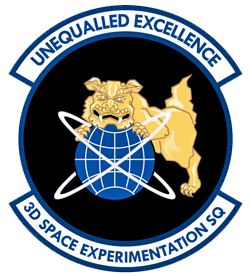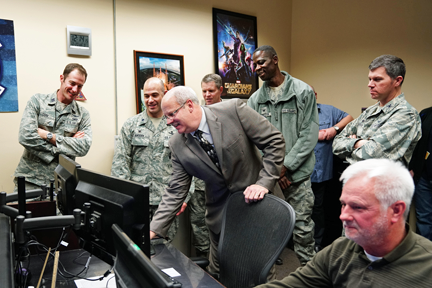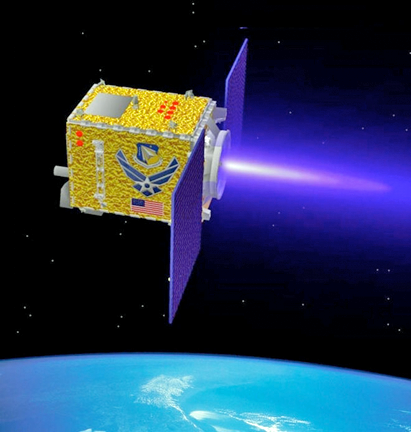
Members of the U.S.A.F.'s 3rd Space Experimentation Squadron (3rd SES) gathered to say goodbye to the Automated Navigation and Guidance Experiment for Local Space satellite during a final command ceremony at Schriever Air Force Base, Colorado, on November 20.

Dr. Joel Mozer, Air Force Space Command acting chief scientist and technical advisor, sends the final command to the now-decommissioned the Automated Navigation and Guidance Experiment for Local Space satellite at Schriever Air Force Base, Colorado, Nov. 20, 2017. Mozer had satellite control authority during the beginning stages of ANGELS in 2014.
U.S. Air Force photo by Dennis Rogers.
ANGELS was an experimental satellite that tested the boundaries of orbital mechanics and capabilities of space systems. The satellite was launched in July 2014, which was initially managed by the Air Force Research Laboratory’s Space Vehicles Directorate at Kirtland Air Force Base, New Mexico. The satellite was designed to demonstrate automated spacecraft operations, advanced Space Situational Awareness capabilities and expand Rendezvous and Proximity Operations techniques.
In July 2016, AFRL transferred satellite control authority to the 3rd SES. This gave the 50th Space Wing a new level of authority over the satellite to dictate tasks and commands directly to the equipment.
“Our mission within 3rd SES is to execute threat replication trajectories for the creation of tactics, techniques and procedures,” said Capt. Matthew Cork, ANGELS flight commander. “We had ANGELS fly a threat replication trajectory for an asset at geosynchronous orbit. This is done to know how to defend against an on-orbit aggressor.”

Artistic rendition of the U.S.A.F.'s ANGELS satellite.
Cork explained the reason for the final command ceremony was due to completion of end-of-life experimentation, no longer having necessary resources available to extend the satellite’s life, as well as freeing up personnel for future missions. The ceremony was to confirm all passivation was complete and declare ANGELS as mission-ended.
The 3rd SES invited Dr. Joel Mozer, Air Force Space Command acting chief scientist and technical advisor, to send the final command. The squadron explained this as fitting because Mozer had satellite control authority during the beginning stages of ANGELS.
“It is generally rare for the same person who received initial satellite control authority for a satellite to be the one whom also sends the final command,” said Lt. Col. Kevin Amsden, 3rd SES commander. “However, Dr. Mozer had recently been asked to fill in as the acting AFSPC chief scientist, so it was very fortunate and quite an honor to invite him back to send the final command.”
During the final contact with the vehicle, the satellite was commanded into the safest, lowest energy state possible. This means all fuel was depleted from the fuel tanks, the batteries were unable to hold a charge and the vehicle was in a spin-stabilized configuration.
“The final command ceremony spanned a spectrum of emotions,” Cork said. “It was nice to see how this space vehicle and its operations have touched so many lives in a meaningful way. It’s always sad to see assets go, because people pour their lives into the operations here. However, it is also a good thing to see, knowing you have done great work and that it will carry on into the future.”
Amsden addressed his team and guests, while looking back on the satellite’s journey from transfer to final command.
“I could not be more proud of the 3rd SES and all the members of the ANGELS team,” Amsden said. “They took this mission and executed a whole series of “first-evers,” demonstrating new tactics, techniques and procedures that will be critical in advancing the future of our nation's space superiority.”
While 3rd SES may have recently decommissioned ANGELS, the squadron continues to look forward into the future. They are gearing up for new programs to include the EAGLE/Mycroft space vehicles, scheduled to launch in April of 2018.
Story by Senior Airman Arielle Vasquez, 50th Space Wing Public Affairs

